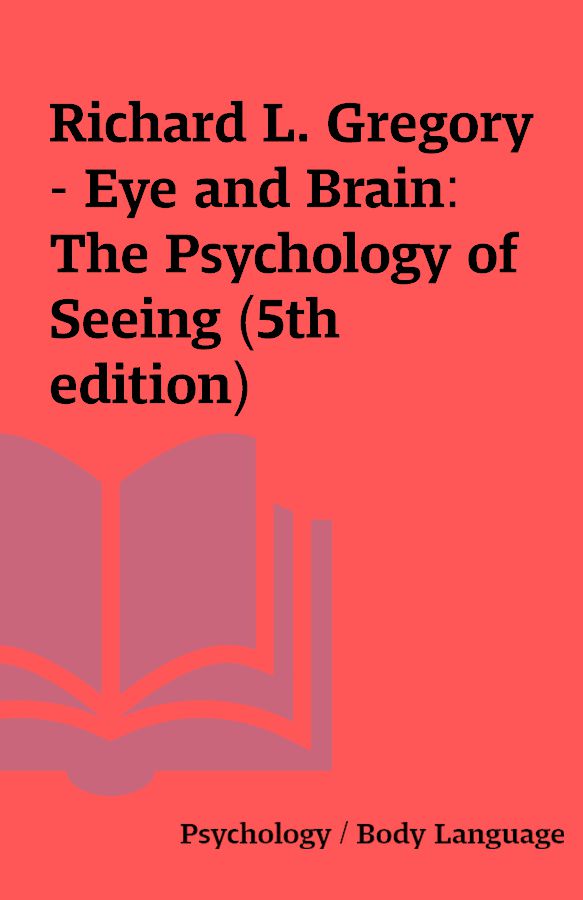Richard L. Gregory – Eye and Brain: The Psychology of Seeing (5th edition)
Eye and Brain – The Psychology of Seeing (5th edition) By Richard L. Gregory.epub
[1 Ebook – EPub]
Description
Eye and Brain: The Psychology of Seeing (5th edition) By Richard L. Gregory1998 | 296 Pages | ISBN: 0691048371 | EPUB | 15 MBSince the publication of the first edition in 1966, Eye and Brain has established itself worldwide as an essential introduction to the basic phenomena of visual perception. Richard Gregory offers clear explanations of how we see brightness, movement, color, and objects, and he explores the phenomena of visual illusions to establish principles about how perception normally works and why it sometimes fails. Illusion continues to be a major theme in the book, which provides a comprehensive classification system. There are also sections on what babies see and how they learn to see, on motion perception, the relationship between vision and consciousness, and on the impact of new brain imaging techniques.Editorial ReviewsReview”[A] hugely influential book. . . . It stands as the essential guide to Gregory’s framework for perception, but also to a whole range of visual demonstrations, illusions, and puzzles that will have you captivated long after you have finished.”–Iain D. Gilchrist, Perception”An excellent introduction to the psychology of vision. It presents what we know, what we don’t know, and what we think. Gregory accomplishes this in an astonishingly succinct and successful book.”–Steven M. Kastenbaum, Science Books & FilmsAbout the AuthorRichard L. Gregory, CBE, FRS, is Emeritus Professor of Neuropsychology at the Department of Experimenttal Psychology, Bristol University. He is a world expert in human visual perception, specializing in investigating brain strategies and theories of perception, and in artificial intelligence. He isalso very active in establishing hands-on science centres (as founder and president of the Exploratory in Bristol).Amazon Top Customer Reviews5.0 out of 5 starsA great introduction to the psychology of perceptionBy Mike Christie on May 13, 2000Quote:Who would have thought that a book about the mechanics, physiology and psychology of seeing could be such a riveting read? This is one of the best popular science books around, and I don’t even think Gregory intended it to be a layman’s book–it’s just so well written and interesting that it will delight lay readers as well as its intended student audience.Gregory starts with a short chapter intended to outline some of the less-obvious issues in understanding how we see. Here, as well as throughout the book, he uses optical illusions to make points. The next chapters cover light itself, and the structure and function of the eye and brain, including accounts of how the eye evolved. The rest of the book discusses brightness, colour, and questions such as “How do we visually determine size?” and “Can machines be taught to see?”The book is full of accounts of intriguing experiments and case-studies. Two examples of many: Gregory and a colleague, Jean Wallace, worked in 1961-1962 with a man of 52 whose sight was restored to him after a life of blindness. The account of his slow and incomplete adaptation to the world of sight, and his ultimate slide into depression and death (he had been active and capable as a blind person) is fascinating and moving. Another example: Gregory discusses various researchers who spent some time wearing vision apparatus that dramatically changed their perceptions, such as Stratton, Ewert and the Paterson’s. In these cases–where for example the wearer could see their own body suspended in front of them, or see everything upside down–the details of the adaptations of perception are thought-provoking and still not completely understood.Strongly recommended.5.0 out of 5 starsClassic work on perception, updatedBy magellan HALL OF FAMETOP 1000 REVIEWER on September 2, 2003Quote:This is the classic introduction to perception and psychophysics, and remains as readable and entertaining as it was 30 years ago when I read the first edition. Gregory’s was one of the few books on the subject accessible to the non-specialist that tackled some of the more difficult topics, such as how the physiology and anatomy of the eye contributes to perception, as in the case of physiological optics, retinal receptive field geometry, ocular domimance and saccadic eye movements, as well as other traditional areas such as color perception, space perception, and so on. There are also very engrossing discussions of split-brain experiments and optical illusions, probably the most fun part of the book for most people, which are worth reading just for themselves. Overall this is still a great book and one that everyone should read to gain better understanding of how their own visual systems and brains work to enable us to see and perceive the many simple and complex aspects of the visual world. After reading this book you’ll have much of the background to read David Marr’s later book, entitled simply Vision. This important work contains discussions of more complex visual cortical brain mechanisms and of Marr’s important work in that area. Marr discusses his important concept of the “primal sketch” for extracting line primitives, which relates to retinal receptive-field geometry, and then works up from there to more sophisticated spatial-frequency filtering algorithms and mechanisms–ideas that revolutionized our understanding of vision and the brain.5.0 out of 5 starsThe Brain’s Deception on VisionBy Hitesh B. Patel on October 1, 2010Quote:This book does an excellent job of explaining the details of vision through various illustrations and examples. I highly recommend this book to people that have a curiosity about vision and why some things seem the way they do in terms of sight and perception. The book is written in more of a textbook format in which it defines many concepts prior to using the terms in the book; this also makes it an easier read for people not familiar with terms both related and associated to the eye and brain. I liked the structure of the book in which the future chapters of the book build upon the concepts and terms introduced in previous chapters. Gregory not only mentions many novel ideas, but he also explains how and who discovered these novel ideas. I thought the book was both entertaining and at the same time informative.Gregory starts off the book by providing illustrations and examples of images in which the mind perceives a familiar object. One such illustration he uses to portray this is a picture filled with black blobs of ink randomly placed around the page except for a certain area (p.12). Even though there is not much of an outline of a Dalmatian dog, the mind makes a guess based on previous information and data it has collected from past experiences that this may be a dog. I thought this was a clever method that Gregory used to capture the reader and helped raise various questions about the process of forming hypotheses within the brain about the outside world.After capturing the reader’s attention, Gregory delves into the details of color and how the eye detects light and different colors via cones and rods. He explains in detail the experiments conducted by Sir Isaac Newton to discover the color spectrum. Also, Gregory establishes the foundations of the eye by describing its anatomy and the importance of each structure. Gregory mentions and also illustrates that the cones and rods which are used for light detection are actually placed in the back of the retina behind other cells, which could reduce the amount of light actually penetrating through the layers to reach the cones and rods. I enjoyed that Gregory consistently used the same format when writing the various chapters of the book; he defined and explained the basics and then built upon that in order to explain something that would otherwise have seem complicated such as the Muller-Lyer illusion (p.219).After explaining the technicalities of the eye Gregory begins to define the second part to this book, which is the brain.”…the brain was regarded as an unimportant organ, because in death it is bloodless and in life it is seldom felt by its owner.”(p.67) I liked how Gregory first gives a very brief snapshot about the impressions of the brain in ancient history and how it was determined to be an important organ later in history. He illustrates the basic unit of the brain, which are nerve cells and how the action potentials are generated as well as carried out throughout the body. In this part of the book, Gregory identifies special cells in the brain associated with orientation of objects and movement of objects. He describes experiments that were conducted in which lines rotated at various angles were shown to a test subject and the recordings of action potentials were collected from the associated cells. Certain cells would fire more frequently when introduced to the line at a certain angle. The same methodology was used in identifying movement related cells in the brain.Once the reader has acquired the necessary tools and background information for the associated jargon, Gregory brings up several interesting ideas and concepts. One such question he presents is, “Why does the world remain stable when we move our eyes?”(p.101). He explains this by stating that both the image-retina systems and the eye-head systems work together and cancel each other out, which results in a stable environment. Also, Gregory mentions that since our movement is active and is controlled by us, the brain can actively predict which direction or orientation we will be facing in the near future; the brain compensates for these movements as a result. One such example used to help understand this notion is the aspect of driving a car. The driver of the car knows in advance when and how they will turn the car or accelerate; for the driver the car ride would seem smooth to them. However, the passenger in the car would be sitting passively and would have no hindsight what so ever if the driver of the car drives aggressively; for the passenger the ride may not be at all considered a smooth ride. Throughout the book, Gregory tries to use explanations that are down to earth and easy to comprehend by the average reader and I believe this makes the reading that much more enjoyable.In the later part of the book, Gregory begins to discuss distortions and illusions, which require the functions of both the eye and brain. He uses a tribe called the Zulus to help explain the affects of culture on depth perception. He reveals how the Zulu culture is surrounded by round objects instead of sharp curves and also living in the forests have mediated their perceptions of seeing at vast distances. Instead, many people from the Zulu tribe believe something that is far away as being small instead. I really enjoyed how Gregory used concepts, ideas, and examples from all around the world.In another study that Gregory discusses, he explains how most of our learning from seeing is initially learned via touching. The study initially involved blind people that recently regained vision and required them to draw a bus. The drawing lacked many of the details of the bus. However, after the subject was allowed to touch the bus physically and was asked to draw the image of the bus again, many of the details that were not present in the first picture were now present.”Depression in people recovering sight after many years of blindness is a common feature of these cases. Its cause… seems to be a realization of what they have missed…” (p.154) Reading the various studies Gregory mentions in his book, I truly came to appreciate the importance of vision. Gregory also mentions how some people from recovering sight are disappointed at what they actually see due to what they may have imagined something to look like before regaining vision. People recovering from sight that experience depression often tend to live in the dark and avoid light.There were very few things that I did not enjoy from reading the book. One such thing was his somewhat poor explanation of the various categories of perception (p.228 – 230). Although he did use illustrations to help with his explanations, I believe he did not do as great of a job at explaining the differences between each category as he did in explaining concepts in other parts of the book.Overall, I liked this book. It made think about vision in many different ways and it also engaged the reader by having illustrations and illusions in the book for the reader to test out. I thought the structure of the book was very well written in terms of introducing new concepts only after introducing the reader to some of the very basic terms and definitions first. Only word of advice I would provide to future readers is to look at the figures as soon as they are mentioned in the readings because this will help visualize the explanation Gregory provides in the text much more clearly. It’s an excellent book to read every night right before going to bed!5.0 out of 5 starsTakes you Eye to Eye into depth about the eye and seeing.By George S. Pearl on July 26, 2013Quote:I like the book because so much is covered about how we see and how the brain is a part of what we think we are seeing.A great research book as well as informative.
You must be logged in to post a review.






Reviews
There are no reviews yet.